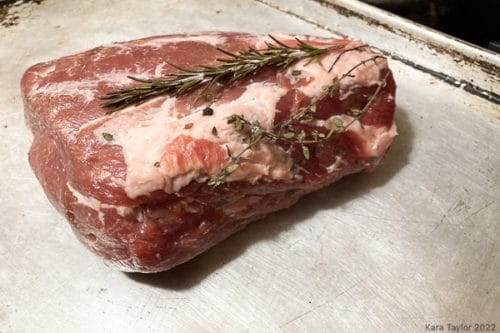Ingredients
For every pound of ham, combine in a mixing bowl:
10 grams (3 Tablespoons) salt
10 grams (1 scant Tablespoon) brown sugar
1.2 g (scant 1/4 teaspoon) curing salt (SEE NOTE BELOW)
1 gram (3 each) peppercorns
1 juniper berry, crushed
1 garlic clove crushed
1 sprig of fresh thyme
1 3-inch sprig fresh rosemary
1 fresh sage leaf
Honey for drizzling later.
Instructions
Rub this mixture all over the uncured ham and drizzle lightly with honey.
Place the ham with any of the excess Cure Mixture that didn’t stick to it in a vacuum seal bag and vacuum seal tightly. If you do not have a vacuum sealer, place the ham in the mixing bowl and cover. Transfer this to the refrigerator.
Every couple of days, flip the ham over. If the ham is not vacuum sealed, rub it down with the liquid brine that has formed in the bowl.
After 6 days if vacuum-sealed or 8 days if not, remove the cured ham from the cure. Rinse it well and place it in a bowl of clean water for 30 minutes. Change the water once or twice during that time. Pat the cured meat dry and leave it uncovered in the fridge for another 1-2 days to form the pellicle and allow the salt concentration to reach equilibrium throughout the meat.

Heat your smoker (or oven) to 200 F. Cook to an internal temperature of 140-145 F. Remove from the smoker (or oven) and let it cool to room temperature before refrigerating. Slice it only after it has cooled all the way down.
Notes
Kitchen Scale is Highly Recommended
Though I gave volume measurements I highly recommend using a scale and sticking with the weight measurements for these ingredients. Volume measurements are approximate. If making a 2-3 lb ham, the margin of error will be minimal. However, the margin of error between the volume and weight increases the more you scale the recipe up. For a 10 or 20 lb batch, you could be off significantly on your curing salt. Too much curing salt is toxic.



